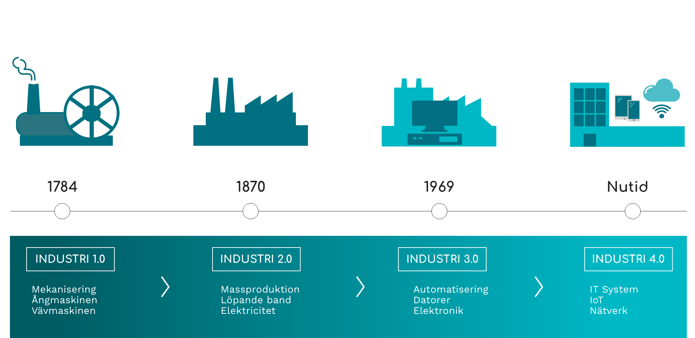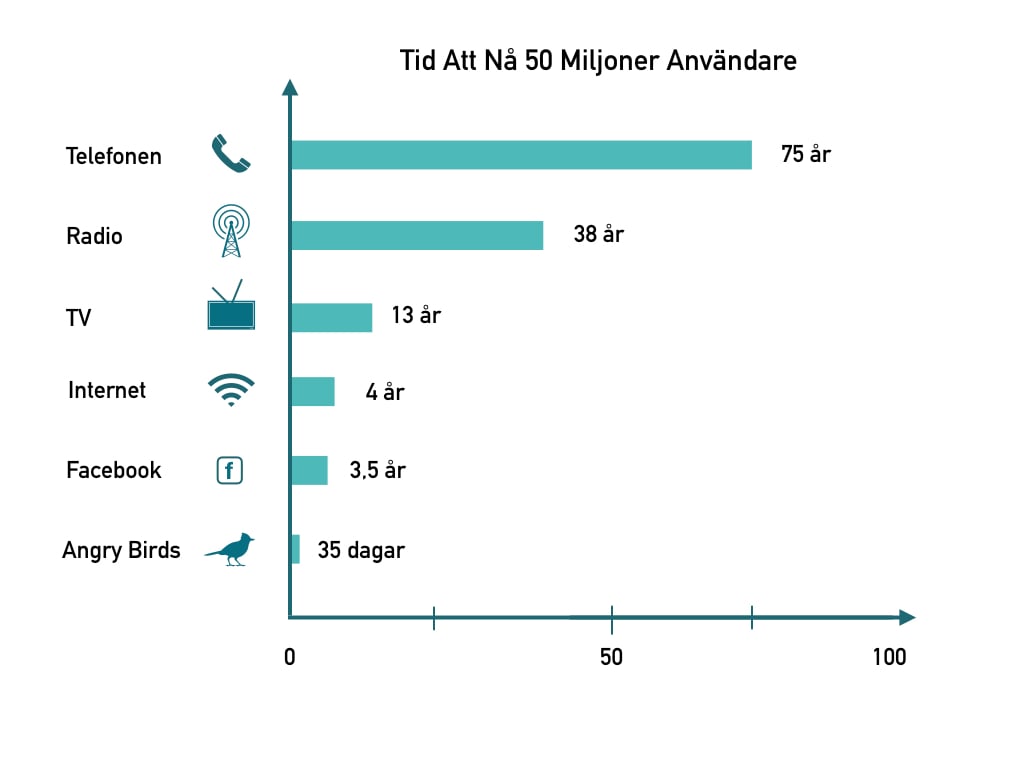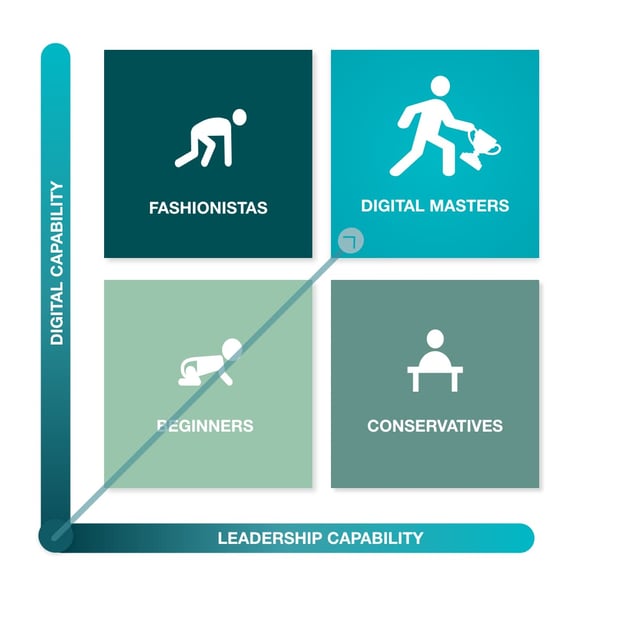
Digital transformation brings about incredible opportunities. The world is facing and experiencing a new industrial revolution. It is evident that digitization and digital transformation have and will impact all aspects of society. Here, we have gathered all our thoughts and insights on the subject. Here, you can gain an understanding of how you can leverage this in your business.

01
For those who have worked in the IT industry or in "technology-heavy" sectors, the concept of digitalization has probably become worn out by now. In the present day, the digital wave reaches industry after industry and affects our work and lives to varying degrees. However, for many, the term is still completely new. If we follow the news flow, we are met with headlines about digitalization, digitalization of schools, digitalization of preschools, digitalization and elderly care.
Digitalization is not a trend; it is a new industrial revolution, an industrial revolution 4.0, which is already rapidly changing the world. Although the pace of change we live in today is extremely fast, it will never be this slow again. Possibly a frightening realization, but still a reality and something we must confront whether we want to or not.
On this page, you will find insights and strategies for digital transformation that can be implemented regardless of the industry or business. In our blog, we occasionally delve into specific industries, where you can find resources that are more tailored to specific sectors such as digitalization and HR, the real estate industry, or leadership.
02
Like all trendy terms, the word "digitalization" has become overused and lost some of its power. However, digitalization is more than just a passing trend. You've undoubtedly come across the term in various contexts, but what does it really mean?
Originally, the word referred to the transfer of information or media from analog to digital, such as converting music from vinyl records to mp3 files or scanning images.
Today, this concept has been narrowed down and is now referred to as "digitization." Digitalization is a broader definition of the phenomenon that has swept the world in recent years. Terms like Healthtech, Fintech, IoT, AI, and AR all revolve around the idea of streamlining and improving industries, products, or services through the use of digital tools.
Digitalization, or digital transformation, is the process by which new technology changes business models, companies, and entire industries at a speed and scale that is difficult to comprehend.
During 2015-2016, digitalization gained momentum. However, new technology as a standalone phenomenon cannot bring about change. Whether it's the internet, IT, AI, VR, or AR, human beings must always be taken into account in the equation. Digitalization or digital transformation occurs at the intersection where human behavior meets new technology – only when technology is implemented and utilized can the full power of digitalization be harnessed.
Digital transformation refers to the journey that a company or industry takes towards digitalization. Many global consulting firms tend to exaggerate the concept and make it seem daunting. At TeQflo, we believe in taking the opposite approach – simplifying and making the journey interesting and developmental.
In summary, here are our key definitions to keep in mind within the realm of digitalization:
Digitization = Converting analog to digital
Digitalization = When humans meet technology (products and services)
Digital Transformation = The journey from point A to point B in digitalization
Let's dig a little deeper.
Digitalization or digital transformation is the dynamic process where new technology revolutionizes business models, companies, and entire industries at a speed and scale that is hard to comprehend.
In 2015-16, digitalization gained real momentum. However, new technologies as standalone phenomena cannot bring about change; neither the internet, IT, AI, VR, nor AR. The human element must always be considered in the equation. Digitalization or digital transformation occurs at the point where human behavior meets new technology - only when technology is implemented and utilized can the full power of digitalization be harnessed.
Digital transformation refers to the journey that a company or industry takes towards digitalization. Many global consulting firms tend to exaggerate the concept, making it seem daunting and overwhelming. At TeQflo, we believe in simplifying and making the journey interesting and enriching.
In summary, here are our key definitions to keep in mind within Digitalization:
Digitization = The process of converting analog information into digital format.
Digitalization = When human beings interact with technology (products and services).
Digital Transformation = The journey of digitalization from point A to point B, where businesses undergo significant changes to adapt to the digital era.
There are countless examples of companies that have undergone incredibly successful transformations. Below, we provide a few examples to give you an idea of how digital transformation can unfold. In our blog, we have gathered even more examples and delved into exciting case studies.
Naturally, the most well-known examples are the ones that most people are familiar with. Of course, we will explore those, but it is also interesting to examine the lesser-known (yet successful) ones. Here, we present 5 fairly well-known examples:
Some notable examples of successful digital transformation include the following:
Uber: Founded in San Francisco in 2009, Uber quickly surpassed the number of traditional yellow taxis in New York by 2015.
Airbnb: Another success story from the vibrant startup scene in San Francisco, Airbnb revolutionized the sharing economy with its innovative business model.
LinkedIn: With a slightly longer history than the previous examples, LinkedIn was founded by Read Hoffman in 2002 and launched as a professional networking platform in 2003.
Amazon: Jeff Bezos, the founder of Amazon, is now a legend in the industry. In 1994, he launched the online bookstore, which has since evolved and expanded to become a leading player in the digital era.
Klarna: In Sweden, Klarna is a shining example of a company that has succeeded by providing secure and convenient payment solutions in response to the increasing demand for e-commerce.
Tibber: Another promising scale-up in Sweden, Tibber has combined smart electric vehicle charging, green energy, and low electricity prices driven by artificial intelligence, offering a superior offering compared to competitors.
These examples highlight the transformative power of digitalization and how businesses can adapt and thrive in the digital era.
The Fourth Industrial Revolution, also known as the Industrial Revolution 4.0, is a reality. The need for digitalization arose long before the new technology even made it feasible.

Named after one of Intel's founders, Gordon E. Moore, Moore's Law describes the exponential growth of the number of transistors that can fit on a chip. This rate, which has been in effect for many years, results in a doubling every 24 months.
The law has proven to be accurate for a long time but has had to be revised in recent years. We may currently be in a period that is somewhat of a turning point. Until now, technology has advanced rapidly, especially when it comes to chips and processors, which have reached nano levels. This means that research and innovation may take longer, but when breakthroughs do occur, development speeds up again.
While our brains have changed over time, they are still programmed in many ways just as they were over 40,000 years ago. This presents limitations and difficulties for us to adapt and keep up with technological advancements. Humans are at the core of development, resulting in digitalization being superior to digitization.
Digitalization is happening all around us, but not at the same time. The timing varies between industries, services, and products. What we have observed is that those with low user-friendliness and high impact are affected first, while those with high user-friendliness and low impact are affected last.
However, don't be fooled into thinking that your industry will remain as it is today. Countless examples exist of start-up companies entering complex and niche industries. Amazon started small by selling books online.
SpaceX handles deliveries to the International Space Station. Several start-ups are attacking the banking industry, leading banks to defensively acquire these companies.
Take a moment to consider your own industry. If user-friendliness is low and the impact of digitalization is high, there are significant opportunities for you to surpass your competitors. Before they surpass you.
The pace and progress of Digitalization can be difficult to grasp. However, most people understand that it is moving very quickly and it certainly feels like it has accelerated. And it has.
The internet, mobile phones, and social media have contributed to faster dissemination today. Local today, global tomorrow. Below, we see a graph that shows various technological breakthroughs and how long it took for them to reach 50 million users.

Internet: When the internet arrived, the world was forever changed. Today, we have incredible opportunities to find information, communicate, and collaborate - on a global scale.
Mobile: The smartphone has become the central platform in our lives, with several hours of screen time every day. We now have almost constant connectivity, allowing for the migration of numerous functions to mobile devices, enabling us to live more and more mobile lives.
Social media: Communication and collaboration on the internet were forever transformed with the founding of Facebook. With over a billion users, it is by far the largest platform. Today, younger generations live digital lives, while middle-aged individuals incorporate digital elements into their physical lives.
Gamification: Perhaps the most underrated driving force is gamification. In short, gamification is the application of game elements in other contexts, such as education and sales.
Does it work? Absolutely.
Is it powerful? Very much so.
Why? Because it stimulates the chemicals in our brain (when designed properly), primarily dopamine, serotonin, and oxytocin. Can it be abused? Yes, gamification relies on the influence of various human motivations. "Black hat" motivations, for example, are heavily used by gaming companies. Luckily, there are "White hat" (positive) motivations that we utilize in gamification projects.
Change affects people, and our natural inclination is to resist rather than embrace it. How we respond to and engage with change varies, but as organizations, we often underestimate its impact. This holds true in all areas, and it can be difficult to elicit an honest answer about how a change actually affects a person. We prefer not to admit that we feel uncomfortable with new technology and changes. We don't want to appear backward and outdated. Instead, we prefer to project an image of being progressive, innovative, and capable, even in the future.
Change can be packaged as large and comprehensive or small and incremental. Regardless of the approach, it is important to keep this in mind. Every change is naturally met with resistance, regardless of how well-intentioned it is and how positive the anticipated impact is for the organization. Change leadership makes a significant difference. Take it into account and invest in it.
Digital transformation (change) is also a generational issue. These four groups are described in the book "Get Digital Or Die Trying". Certainly, the content is generalizing but often elicits laughter when presented to groups. The four groups are:
Digital Dinosaurs (grandparents): They lack a deeper understanding of digitalization.
Digital Immigrants (parents): They have some understanding. They use email, etc.
Digital Natives (Born 1980-2000): They grew up with computers and the internet. 91% use the internet on their mobile phones, 80% have Facebook.
Digital Alphas: They believe that the real world is digital.
We often hear that digital transformation is extensive. This is true because it spans across various areas in a typical company. It affects business models, IT, sales, customer relationships, leadership, marketing, and more. Therefore, digital transformation should be viewed from a holistic perspective when implementing it as a company. Additionally, digital transformation can also be categorized effectively.
Internal Digitalization: This category encompasses IT and technology in a simplified manner. It refers to the infrastructure that can enhance and transform internal processes, such as business systems, integrations, hardware, licenses, and more. Internal digitalization drives efficiency within the organization and primarily impacts costs.
External Digitalization: External Digitalization drives external attractiveness, which includes digital communication tools, sales, marketing, and customer service. Unlike internal digitalization, the growth of the company is influenced by external digitalization. Building a presence on social media, utilizing digital marketing, automated sales and marketing processes, and customer service are examples of external digitalization.
Business Models: Digitalization has brought about completely new and often incredible opportunities. It is in the realm of business models where the most memorable transformations occur. Companies that have recognized the potential, listened to their customers, and acted accordingly are the ones that will have the best chances of thriving in the digital future. For instance:
Leadership: Digital mastery is not just the aspect of digitalization that we find to be most neglected. As mentioned earlier, people often have different attitudes towards change, and this attitude is important to be able to handle in order to implement digital transformation with the best possible results.
The above text is primarily sourced from the following references:
03
Below, we delve into the following areas:
Anything that can be digitized will eventually be digitized.
By understanding what digitalization truly entails, we can also grasp the reasons why it is crucial to embrace it. The above quote, once again taken from the digitalization bible "Get Digital Or Die Tryin'," encapsulates the simple and concise answer to the question of why digitalization is necessary. We prefer to use the term "digitized" as it encompasses not only the technological aspect but also includes people, making digitalization truly unique. Since everything that can be digitized will eventually be digitized, we arrive at principle 2.
EVERYTHING THAT IS DIGITIZED CAN BE REPLICATED
What becomes increasingly digitized can also be more easily replicated.
ANYTHING THAT CAN BE REPLICATED LOSES VALUE
So how should we approach this harsh reality? It's actually not as bleak as it may sound, as it brings forth incredible opportunities for those who choose to embrace digital transformation.
EVERYTHING THAT CANNOT BE DIGITIZED/DIGITALIZED INCREASES IN VALUE
In an increasingly digital world, the importance of the human element becomes more significant. Technology, robots, algorithms, and software often fail to satisfy our human needs. As a result, the deeply human aspects gain value. Digital transformation is not just about technology or humans; it is about the synergy between humans and technology, with humans leading the way.
Certainly, it may sound dramatic. However, the majority of businesses have now realized that some form of digitalization is necessary in order to have a chance in the future market.
Blockbuster was once a giant in the American film market, considering themselves as titans. However, on the sidelines, digital solutions like Netflix started making waves. In the early stages of digitization, it wasn't as clear to invest in the future, and unfortunately, it led to Blockbuster's downfall. As consumer behaviors rapidly changed, the costs became too high compared to the revenues.
On the other hand, there are shining examples of how digitalization can be turned into an advantage. Netflix was among the pioneers with a digital solution and global expansion. The common thread among the survivors is that they have transformed their business models and created digitized solutions to adapt to new consumer behaviors.
Westerman, Bonnet, and McAfee conducted a fascinating study on digitalization and made an intriguing conclusion. The digital master outperformed its industry peers in terms of profitability and sales productivity.
These two effects are likely among the most coveted in strategies, business plans, and goals. The results also transcended industries.
But what defines a digital master? Two key factors create Digital Masters: Digital capability and leadership ability. The digital capability involves selecting and utilizing smart, digitized solutions based on the company's context. Furthermore, leadership is required to implement the digital tools and optimize work processes.
The digital capability involves the selection and utilization of intelligent, context-based digital solutions within the company. Furthermore, effective leadership is essential to implement these digital tools and optimize work processes.
The researchers were able to categorize the surveyed companies into four groups:
Beginners: Those who have not yet started with digitized solutions or do not have the leadership to implement them.
Conservatives: This group is also not yet active, but they are otherwise well-run companies with good leadership. Things get done, just not in digital solutions.
Fashionistas: In this group, we find technology pioneers. These companies want to try out new cool solutions but struggle to realize the business value.
Digital masters: This group combines the best of Fashionistas and Conservatives. They have chosen the right solutions from the business and implemented them in an impressive way. The results speak for themselves, with improved profitability and sales productivity.

Source: "The Digital Advantage: How Digital Leaders Outperform Their Peers in Every Industry," a study conducted by Capgemini Consulting and MIT Center for Digital Business in November 2012.
Many companies have implemented digital tools, which can include marketing through social media, search engines, and comparison websites. Even in this area, there has been development since the internet became widely used worldwide. Perhaps many systems have also been digitized, such as time reporting and accounting. But as we have demonstrated, the development continues.
Not all trends and technologies necessarily need to be acted upon, but monitoring the external environment is more important than ever. Being able to decide what to act on or not can be crucial. A good piece of advice to stay ahead is to look at a decision support system and monitoring tools. In reality, for most, we would recommend gradual improvement towards becoming a Digital Master. How? You can read more about it in the next section.
04
As we have discussed before, digitalization involves both technology and human behavior. It often entails a significant change. However, when implementing a change in an organization, a serious mistake is overlooking how it will affect people. Change itself can be uncomfortable, and introducing new tools or work methods to a group with varying levels of knowledge requires solid change leadership.
Below, we will go through four steps to initiate the necessary change for digitalization.
Get started with the transformation process.

The challenge of leadership and change is often greater than the technological challenges in most cases. Therefore, important preparations include:
Many people underestimate the importance of these three steps. This often leads to uncoordinated digitalization, personal agendas taking over, and valuable resources being wasted.
Once the vision is set, the crucial work begins - getting started. It is often easier said than done, and we often see decisions being delayed for unclear reasons.
The three crucial steps for maintaining focus are:
Digital transformation becomes tangible only when the activities are clear, well-planned, and measurable. If it seems vague and difficult to comprehend, keep digging until explicit activities emerge.
It is not uncommon for the responsibility of the digitalization journey to be given to the person who already has the most on their plate. This is a mistake for at least two reasons. Firstly, because transformation is a "journey together" and secondly, because digitalization takes up a lot of time. It is important to agree on reasonable goals and expectations beforehand.
The budget still plays a significant role in many organizations. If it is included in the budget, we have the authority to carry out the necessary actions, or we have to find creative ways to work with the existing resources. However, relying too heavily on the budget can result in slow decision-making and delayed outcomes. Similarly, the budget for digitalization should be flexible. In agile or semi-agile work environments, opportunities and challenges often arise during the process. Therefore, it is crucial to navigate effectively and be adaptable.
To summarize, it is essential to create an environment that allows for quick and high-quality decision-making - proactively.
Now is the time to begin the actual work. A strong start in the change process towards the entire organization is crucial - yet it is easy to overlook or budget away the change budget. The following three sub-steps are important:
Understanding the direction and involving everyone in the journey is crucial. Knowing why and where we are going together is powerful but also challenging to communicate effectively.
Organize and engage your employees in the change. It's not just about the management; key individuals are the most affected. The more engagement you can create, the better solutions will be generated.
The potential of digitalization is sometimes wasted due to a lack of willingness to change. Old work processes are translated literally into new systems. Digitalization presents an excellent opportunity to evaluate, transform, and optimize your work processes for maximum value.
Digital masters are never finished. There is always the potential for growth - neither the world nor the competitors stand still.
The following three key steps are crucial in the everlasting "final" phase:
After the successful phases 1-3, a lot has changed in your company. However, often the people remain the same, in terms of numbers, skills, and culture. This is where the journey of continuous learning needs to continue. Help your resources evolve and adapt to ensure access to new critical resources.
Sometimes, changes are implemented, but the incentives, both external and internal, remain intact. It's like conveying that the old ways still apply, and old behaviors tend to linger. Design the rewards according to your new world. And remember, younger individuals consider the internal incentives as highly important while the external ones are hygiene factors.
Today, the challenge of leadership and change is often greater than the technological challenges. Therefore, it is recommended to make preparations including a current situation analysis, digital vision, and a digital strategy. The purpose is to understand the starting point and visualize the goal.
Stay focused on your own domain while keeping a close eye on your competitors. By staying one step ahead of them, you will gain a significant advantage and pave the way for your success in your industry.
Now you have a much deeper understanding of digital transformation, why it is important, and how to navigate through it. The recommended next steps are:

